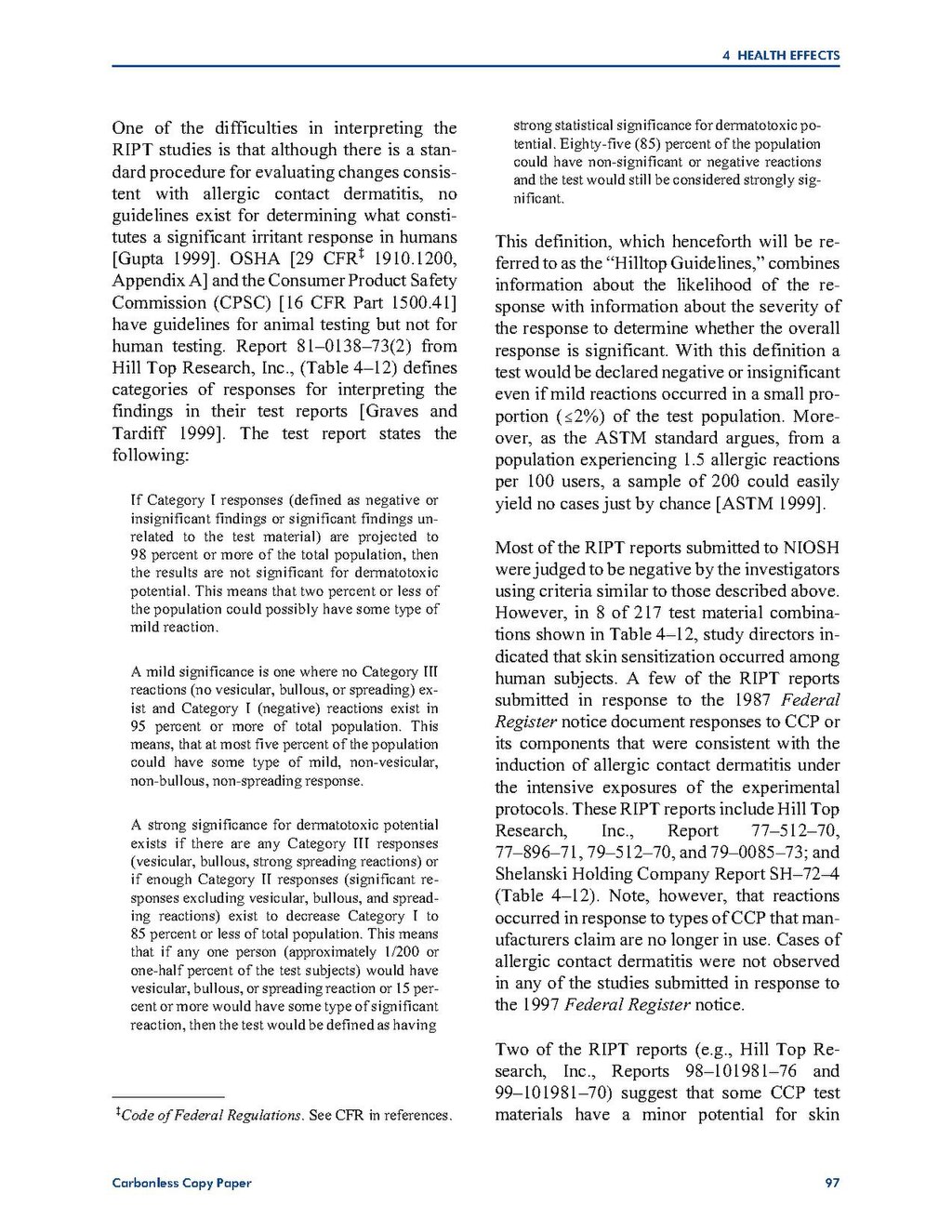One of the difficulties in interpreting the RIPT studies is that although there is a standard procedure for evaluating changes consistent with allergic contact dermatitis, no guidelines exist for determining what constitutes a significant irritant response in humans [Gupta 1999]. OSHA [29 CFR[1] 1910.1200, Appendix A] and the Consumer Product Safety Commission (CPSC) [16 CFR Part 1500.41] have guidelines for animal testing but not for human testing. Report 81—0138—73(2) from Hill Top Research, Inc., (Table 4-12) defines categories of responses for interpreting the findings in their test reports [Graves and Tardiff 1999]. The test report states the following:
If Category 1 responses (defined as negative or insignificant findings or significant findings unrelated to the test material) are projected to 98 percent or more of the total population, then the results are not significant for dermatotoxic potential. This means that two percent or less of the population could possibly have some type of mild reaction.
A mild significance is one where no Category III reactions (no vesicular, bullous, or spreading) exist and Category I (negative) reactions exist in 95 percent or more of total population. This means, that at most five percent of the population could have some type of mild, non—vesicular, non—bu1lous, non—spreading response.
A strong significance for dermatotoxic potential exists if there are any Category III responses (vesicular, bullous, strong spreading reactions) or if enough Category 11 responses (significant responses excluding vesicular, bullous, and spreading reactions) exist to decrease Category I to 85 percent or less of total population. This means that if any one person (approximately 1/200 or one-half percent of the test subjects) would have vesicular, bullous, or spreading reaction or 15 percent or more would have some type of significant reaction, then the test would be defined as having strong statistical significance for dermatotoxic potential. Eighty-five (85) percent of the population could have non-significant or negative reactions and the test would still be considered strongly significant.
This definition, which henceforth will be referred to as the "Hilltop Guidelines," combines information about the likelihood of the response with information about the severity of the response to determine whether the overall response is significant. With this definition a test would be declared negative or insignificant even if mild reactions occurred in a small proportion (≤2%) of the test population. Moreover, as the ASTM standard argues, from a population experiencing 1.5 allergic reactions per 100 users, a sample of 200 could easily yield no cases just by chance [ASTM 1999].
Most of the RIPT reports submitted to NIOSH were judged to be negative by the investigators using criteria similar to those described above. However, in 8 of 217 test material combinations shown in Table 4-12, study directors indicated that skin sensitization occurred among human subjects. A few of the RIPT reports submitted in response to the 1987 Federal Register notice document responses to CCP or its components that were consistent with the induction of allergic contact dermatitis under the intensive exposures of the experimental protocols. These RIPT reports include Hill Top Research, Inc., Report 77-5 12-70, 77-896-71, 79-512-70, and 79-0085-73; and Shelanski Holding Company Report SH-72-4 (Table 4-12). Note, however, that reactions occurred in response to types of CCP that manufacturers claim are no longer in use. Cases of allergic contact dermatitis were not observed in any of the studies submitted in response to the 1997 Federal Register notice.
Two of the RIPT reports (e.g., Hill Top Research, Inc., Reports 98-101981-76 and 99-101981-70) suggest that some CCP test materials have a minor potential for skin
- ↑ Code 0f Federal Regulations. See CFR in references.
